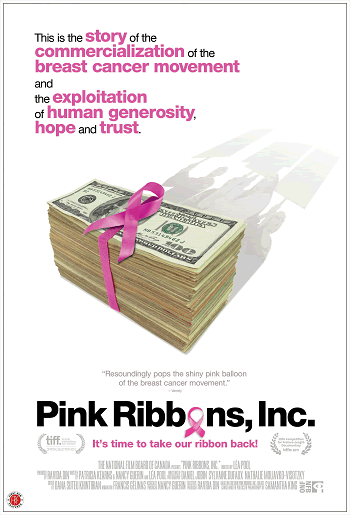| Pink Ribbons, Inc. (2011) Educator Guide |
|---|
| www.studenthandouts.com ↣ Film Guides ↣ Documentary Guides |
 Length: 98 minutes (1 hour, 38 minutes)
Length: 98 minutes (1 hour, 38 minutes)Review: Pink Ribbons, Inc. examines the role of corporate sponsorship in the movement to eradicate breast cancer. It provides a succinct overview of the breast cancer movement in its various forms, as well as criticism from experts and breast cancer sufferers on the inadequacies of early detection education. The film offers no narration; interviewees and visual aids speak for themselves. This documentary film is an excellent tool for teaching students about modern health issues while simultaneously educating them about the politics involved with disease and health care today. The film provides excellent opportunities for increasing critical thinking skills. Vocabulary terms as well as possible classroom review and discussion questions are provided below. Age Appropriateness Rating: Pink Ribbons, Inc. is not officially rated in the United States. It contains no sex or violence, and is safe for viewing by high school students. Creators and Stars: Lea Pool, Dr. Samantha King, Ravida Din, Barbara A. Brenner, Dr. Charlene Elliott, Barbara Ehrenreich, Dr. Susan Love, Nancy Goodman Brinker, Maricela Ochoa, Nancy Guerin, Patricia Kearns, Judy Brady, Jeanne Collins, Sandy Kugelman, Evelyn Lauder, James Brophy, Janet Collins, Carol Cone, Charlotte Haley, Jane Houlihan, Mark Hurlbert Ph.D., Dr. Marion Kavanaugh-Lynch, Margaret Keith Ph.D., Ellen Leopold, Kim McInerney, Dr. Olufunmilayo L. Olopade M.D. Accuracy: This documentary film is based on the book Pink Ribbons, Inc.: Breast Cancer and the Politics of Philanthropy by Samantha King. It contains interviews with experts on breast cancer and breast cancer research fundraising, women suffering from the disease, as well as footage from advertising campaigns and cancer awareness fundraising walks. Click here to enlarge the film poster. Vocabulary terms: activism, bellicose, breast cancer, carcinogen, cause branding, cause marketing, consumerism, early detection, estrogenic, hope, insidious, inspiring, mammogram, philanthropy, rGBH (recombinant bovine growth hormone), strategic philanthropy Review and discussion questions: (1) How many women die each year from breast cancer in North America? 59,000 (2) Under what U.S. president was a shift made from government funding to corporate philanthropy? Ronald Reagan (3) What was a woman's lifetime risk of breast cancer in the 1940s? 1 in 22 (4) What was a woman's lifetime risk of breast cancer in 2011? 1 in 8 (5) According to Barbara A. Brenner, why is early detection through mammograms the "wrong message" to send women about breast cancer prevention? Answers will vary, but should touch upon the failure to educate women on preventing breast cancer from ever occurring (6) According to some of the interviewees in this film, what is troublesome about using terms such as "battle" and "survivor" in conjunction with breast cancer? Answers will vary (7) What are the three "slash, burn, poison" treatment options for breast cancer, unchanged for decades? Surgery, radiation, chemotherapy (8) According to some of the interviewees in this film, why do the "pink ribbon" charities shy away from environmental issues? Answers will vary (9) Describe the perceived shift from activism to consumerism. Answers will vary (10) Has Pink Ribbons, Inc. changed how you view popular breast cancer awareness movements? Explain your answer. Answers will vary Recommended for further reading and information on this film and its content: King, Samantha. Pink Ribbons, Inc.: Breast Cancer and the Politics of Philanthropy. Ehrenreich, Barbara. "Welcome to Cancerland". Brinker, Nancy G. Promise Me: How a Sister's Love Launched the Global Movement to End Breast Cancer. Elliott, Dr. Charlene. "Pink!: community, Contestation and the Colour of Breast Cancer". Leopold, Ellen. A Darker Ribbon: A Twentieth-Century Story of Breast Cancer, Women, and Their Doctors. Love, Dr. Susan. Dr. Susan Love's Breast Book, Susan G. Komen for the Cure, First Run Features |
 |  |  |  |  |  |
| www.studenthandouts.com ↣ Film Guides ↣ Documentary Guides |








